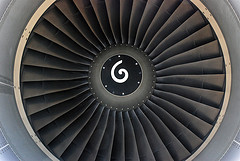Early this month, two sets of photos hit the Internet claiming to be the clearest images of UFOs ever recorded. (See set one and set two.) The furious and multifaceted debate over the authenticity of these photos expresses a crucial turning point in our consciousness: We have learned how to obfuscate reality so well through media technology that it is no longer possible to definitively determine what is "real."
The debate over the recent "drone" images (so called due to the apparent unmanned nature of the objects) has been one of the most heated and multifaceted I have seen. I have read solid arguments that the objects are alien in origin; a secret government project; an automated Forest Service device; a viral-marketing tie-in to a film or video game; and lastly, simply a Photoshopped hoax.
Each argument presents credible evidence by emphasizing certain pieces of information and discounting others, yet the majority of those captivated by these photos lean toward hoaxing of some sort as the most likely possibility. Many have come to this conclusion largely due to the ease with which fakery can be passed off as truth — in other words, the photographs appear so clear that they must be faked. One debunker, motivated to illustrate the simplicity of hoaxing, created a video stitched together from nothing more than a CG rendering of a "drone" and a still photograph for background. As an armchair visual effects geek, I was stunned by the complete believability of the fabrication. We have become quite proficient in imitating life.
Ironically, it is decades of hard work in the entertainment industry that have led to the current state of confusion. In the late 1990s/early 2000s, the Matrix trilogy spearheaded a new level of photorealism in visual effects — one that the trilogy's visual effects supervisor, John Gaeta, recognized as potentially problematic. "I wrote a letter to President Clinton that went unanswered," he told WIRED Magazine's Steve Silberman, "in which I said, 'I am one of the few people who happens to know that the threshold is being broken right now in creating virtual humans[.]' […T]hese techniques will be pushed way beyond providing entertainment into esoteric scientific and military usages. There will be a lot of blurred lines in the next few decades."
Quantum physics seems to sometimes require a Zen-like acceptance of paradoxical things which are simultaneously true. Yet the frantic tone of the "drone" debate in particular indicates that we are still desperate for binary answers and frightened by the blurring of the lines. Accepting the multiple possibilities inherent in the "drone" images or other unknowns is not an option for most humans at this time. Faced with an image not immediately explainable, neutrality is almost impossible.
If we are so uncomfortable with blurred lines, why have we gone to such lengths to gain the technology necessary to obfuscate formerly clear demarcations between fantasy and reality? Everything from cyberspace to virtual reality suggests that we pine for a confusion of "truths." Perhaps we are, somewhat unwittingly, leading ourselves down the path necessary to become familiar and comfortable with multiple realities.
In many ways, experience is now the only authority — everything that is not directly experienced may be altered, faked, or tweaked. Then again, thinking along this line for long leads to the question of whether experience, too, can be faked. Certainly history is filled with eyewitnesses who did not see what they thought they saw. Ultimately, we already choose the reality we live in by selecting what to see and what not to see, what to believe and what not to believe. Whether you live in a world where alien drones monitor the population or a world where manipulative hoaxers maliciously spread false images is, for now, determined solely by your choice of belief.
* NEW POSSIBLY VERY IMPORTANT INFORMATION ON THIS PHENOMENON FOUND HERE:
http://isaaccaret.fortunecity.com/
More about this in comments below – check out the diagrams, which seem to have a relationship to crop circle imagery of the last decades.
Image of a jet engine by Johnny Vulkan via Flickr under Creative Commons license.















